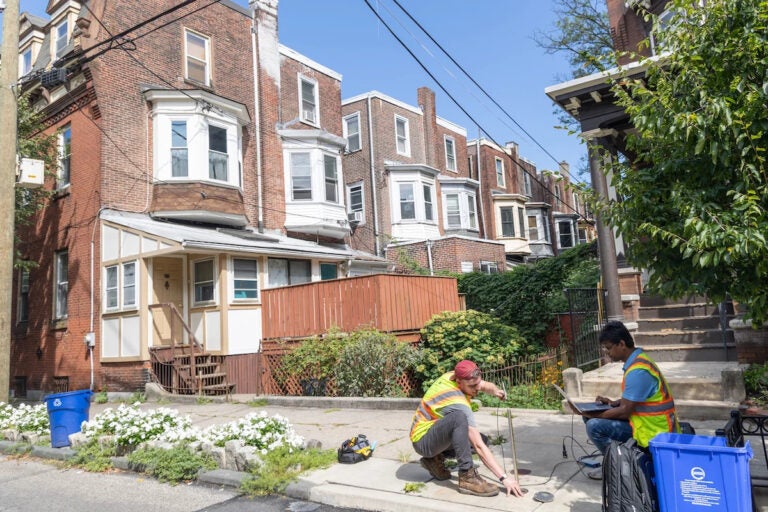Philly children are exposed to dangerous lead more often than in other cities, analysis finds
An analysis by Drexel researchers found the highest-risk cities had higher rates of poverty, a higher percent of Black residents and more old homes.
Listen 1:14
File - In 2023, a Drexel University PhD student and a senior research scientist create a sound wave that will later be analyzed to determine if water service lines are made of lead on Osage Avenue in Philadelphia. (Kimberly Paynter/WHYY)
From Philly and the Pa. suburbs to South Jersey and Delaware, what would you like WHYY News to cover? Let us know!
Close to one in 25 children under the age of 6 in Philadelphia have elevated levels of dangerous lead in their blood, according to a new study. That rate is more than double the average for a group of large cities Drexel University researchers examined in a recent analysis.
“It’s not surprising that [Pennsylvania’s] largest city would send out in this report, just because of the age of the housing,” said Rosemarie Halt, a health policy consultant at the nonprofit Children First PA and the Lead Free Promise Project, a coalition of Pennsylvania organizations pushing for policies that protect children from lead poisoning.
Lead can slow children’s development and cause learning and behavioral problems. The neurotoxin can lurk in peeling paint in old homes, plumbing and soil — and it’s a big issue in cities like Philadelphia with old housing stock. There’s no safe level in a child’s blood.
Philly’s lead exposure is dropping over time, but disparities remain
The Drexel researchers obtained and analyzed lead testing data from close to three dozen cities involved in the Big Cities Health Coalition, between 2017 and 2022.
They found that only two cities — Cleveland and Detroit — had higher rates of young children with elevated blood lead levels than Philadelphia in 2022.
Despite its relatively high rate, Philadelphia has made strides in recent years. The city nearly halved its rate of children under 6 with blood lead levels above 5 micrograms per deciliter (μg/dL) between 2017 and 2022, bringing the rate down from close to 7% in 2017 to just under 4% in 2022. According to the Philadelphia Department of Public Health, the percentage of Philly children newly found to have blood lead levels above 3.5 and 10 μg/dL has also trended down since 2011.
“The city has made great strides … potentially owing to the success of the lead programs within the city,” said Jack Pellegrino, a Drexel master’s degree student studying epidemiology who worked on the analysis.
While federal health agencies say there’s no safe level of lead, the Environmental Protection Agency sets a “reference value” used to identify when a child’s blood lead level is higher than the vast majority of other children. The agency revised this level from 5 down to 3.5 μg/dL in 2021. The Drexel researchers used a threshold of 5 μg/dL to indicate elevated blood lead levels in their analysis since some cities still use that higher threshold, said Amy Auchincloss, an epidemiologist in the Drexel Dornsife School of Public Health who worked on the analysis.
The researchers found the cities with the highest rates of elevated blood lead levels also had higher rates of poverty, more old homes, a higher percentage of Black residents and more segregation between Black and white residents in housing.
“The residential segregation piece really highlights the environmental injustices that have been perpetuated by long-standing systems of structural racism and economic inequality,” Auchincloss said. “Scholars have talked about the historic redlining and how families are being restricted into certain areas and those areas can be areas of concentration of lower-quality housing as well as the disproportionate burden of industrial toxins in soil.”
In Philadelphia, elevated blood lead levels most frequently affect Black toddlers and toddlers living in West and North Philly.
Lead paint and lead-contaminated dust are a big danger for young children, because they can eat peeling paint chips or be exposed to dust when crawling on the floor.
In Philadelphia, researchers have found that housing built before 1980 — indicating the likely presence of lead paint, which was banned for residential use in 1978 — and demolitions of older homes are most correlated with children’s blood lead levels. More than 82% of Philly’s housing units were built before 1980, according to the 2023 American Community Survey.
Philadelphia was also home to many lead smelters — a legacy that lives on in lead-contaminated soil.
Low levels of testing introduce uncertainty
While Philly’s ranking is striking, there’s wide variation in the percent of children who were tested for lead in the cities included in the analysis, noted Marilyn Howarth, an adjunct professor of pharmacology at the University of Pennsylvania who has studied the factors linked to lead exposure in Philly and was not involved in the Big Cities Health Coalition analysis.
Boston had the highest rate of testing in 2022, with 40% of children under the age of 6 having their blood tested for lead. Philadelphia tested roughly 27% of young children in 2022, while eight cities, including Phoenix and Seattle, tested fewer than 10%, according to the Big Cities Health Coalition data.
These low testing rates mean there’s some uncertainty in the city rankings the analysis produced, Howarth said.
“The cities that are showing high rates [of lead exposure] here may be the ones that are doing a better job at testing, and some of the towns with lower rates may just not be testing very many children,” she said.
Conversely, cities with low testing rates may target higher-risk children, making rates of elevated blood lead levels in those cities appear higher, the Drexel researchers said.
While Philly’s testing rate is higher than some cities, it dropped during the first year of the COVID-19 pandemic and has not fully rebounded to pre-pandemic levels, according to the Big Cities Health Coalition data. This means it’s difficult to say whether recent policies to protect children from lead poisoning in Philadelphia — such as a requirement that landlords certify their properties as lead-free or lead-safe in order to rent them out — have caused the improvement in Philly’s rate of lead exposure, Howarth said.
“It’s hard to know if we can really call it a success yet, but it’s certainly trending in the right direction,” she said.
How to protect your children from lead poisoning
Experts recommend making sure your child does not have access to surfaces covered with lead paint, particularly cracking or peeling paint. Areas subject to wear-and-tear, including friction from opening and closing windows and doors, are especially likely to create lead paint chips and dust.
“[Parents] want to make sure that they keep all painted surfaces in good repair, especially window sills, stairwells and radiators,” said Dr. Kevin Osterhoudt, medical director of the Poison Control Center at Children’s Hospital of Philadelphia.
Minimize dust in your home with frequent cleaning, but focus on wet-mopping and wet-wiping, rather than sweeping or vacuuming, Osterhoudt said. The Centers for Disease Control and Prevention also recommends regularly washing children’s hands and using qualified professionals to remove lead-based paint, to avoid creating dust.
If you rent your home, the city of Philadelphia recommends reporting any chipping paint to your landlord. If your landlord fails to repair the paint quickly and safely, you can call 311 to request the Department of Licenses and Inspections perform a home inspection.
Beyond reducing a child’s exposure to lead, there are factors that can lessen the impact lead has on their health.
“A healthy diet actually helps prevent the lead from being absorbed as easily in a child,” Halt said.
The CDC also recommends getting your child a blood lead test through a health care provider, even if they have no obvious symptoms of lead exposure.

Subscribe to PlanPhilly
WHYY is your source for fact-based, in-depth journalism and information. As a nonprofit organization, we rely on financial support from readers like you. Please give today.









